|
 |
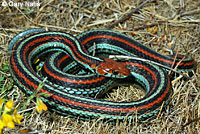 |
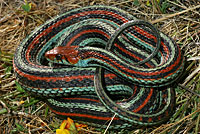 |
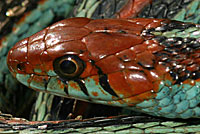 |
| |
Adult, San Mateo County |
|
Adult, San Mateo County |
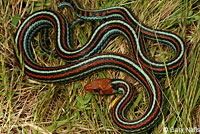 |
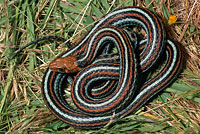 |
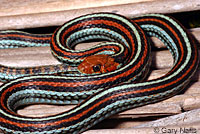 |
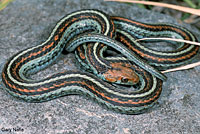 |
| Adult, San Mateo County |
Adult, San Mateo County |
Adult, San Mateo County |
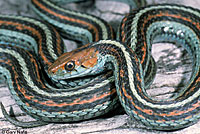 |
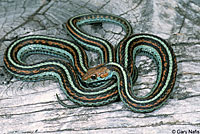 |
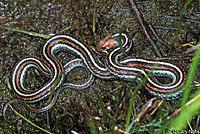 |
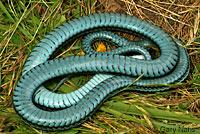 |
| Adult, San Mateo County |
Adult, San Mateo County |
Underside of adult, San Mateo County |
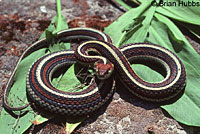 |
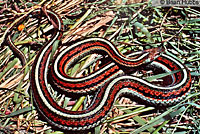 |
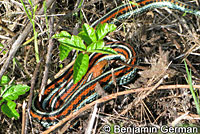 |
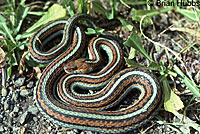 |
Pale-striped adult, San Mateo County
© Brian Hubbs |
Pale-striped adult, San Mateo County
© Brian Hubbs |
Adult, San Mateo County
© Benjamin German |
Adult, San Mateo County
© Brian Hubbs |
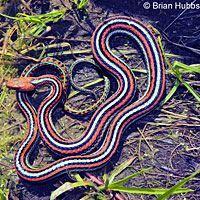 |
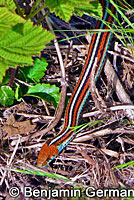 |
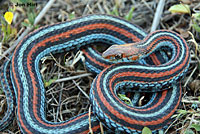 |
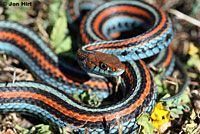 |
Adult, San Mateo County
© Brian Hubbs |
Adult, San Mateo County
© Benjamin German |
Adult, San Mateo County © Jon Hirt |
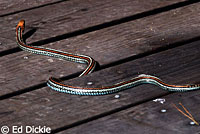 |
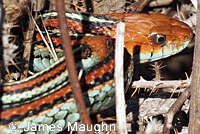 |
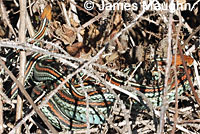 |
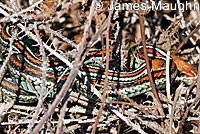 |
| Adult, San Mateo County © Ed Dickie |
A pair of mating adults seen in early March, San Mateo County © James Maughn |
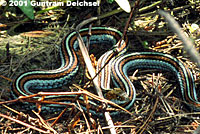 |
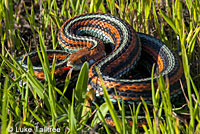 |
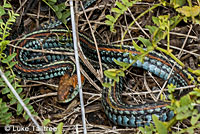 |
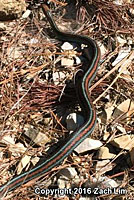 |
Adult, San Mateo County
© Guntram Deichsel |
Adult, San Mateo County
© Luke Talltree |
Adult, San Mateo County
© Luke Talltree |
A very dark adult, Santa Cruz County
© Zach Lim |
 |
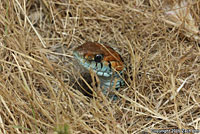 |
 |
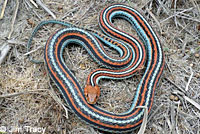 |
A San Francisco Gartersnake in San Mateo County emerges from
a gopher hole to bask near a Coast Gartersnake. © Zach Lim |
Gravid adult female, San Mateo County © Jim Tracy
|
Gravid adult female, San Mateo County © Jim Tracy
|
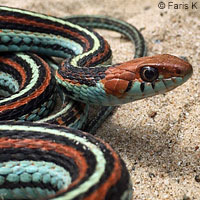 |
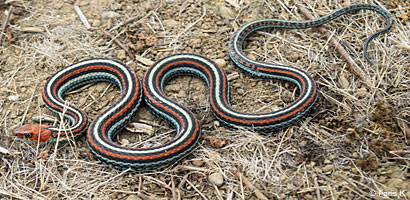 |
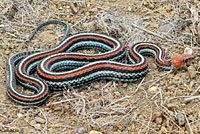 |
Adult, San Mateo County
© Faris K |
Adult, San Mateo County © Faris K |
Adult, San Mateo County
© Faris K |
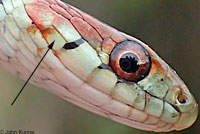 |
|
|
|
| Common Gartersnakes, which include S.F. Gartersnakes, have an average of 7 upper labial scales, but sometimes they have 6, 8, or even 9, and rarely, as you can see above, one of the upper labial scales is split horizontally. This aberration occurs on both sides of the head of the snake illustrated above from San Mateo County. © John Kunna |
|
|
|
| |
|
|
|
| San Francisco Gartersnake Stuff |
 |
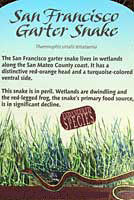 |
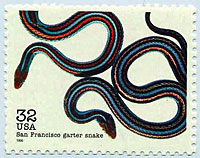 |
 |
San Mateo County Sign
© Brian Hubbs
|
San Mateo County Sign |
1996 U.S. postage stamp from the Endangered Species series |
Stuffed S.F. Gartersnake displayed at the airpot in Brisbane Australia |
| |
|
|
|
| Habitat |
 |
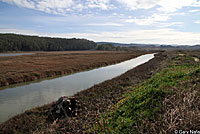 |
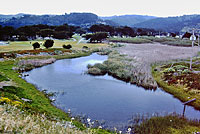 |
 |
| Habitat, San Mateo County |
Habitat, San Mateo County |
Habitat, San Mateo County
|
Habitat, San Mateo County |
 |
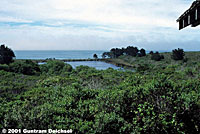 |
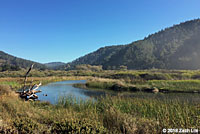 |
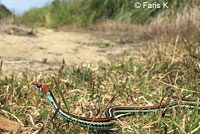 |
| Habitat, San Mateo County |
Habitat, San Mateo County
© Guntram Deichsel |
Habitat, Santa Cruz County
© Zach Lim
|
Adult in habitat, San Mateo County
© Faris K |
|
|
|
|
|
Description |
Not Dangerous - This snake may produce a mild venom that does not typically cause death or serious illness or injury in most humans, but its bite should be avoided.
Commonly described as "harmless" or "not poisonous" to indicate that its bite is not dangerous, but "not venomous" is more accurate since the venom is not dangerous. (A poisonous snake can hurt you if you eat it. A venomous snake can hurt you if it bites you.)
Long-considered non-venomous, discoveries in the early 2000s revealed that gartersnakes produce a mild venom that can be harmful to small prey but is not considered dangerous to most humans, although a bite may cause slight irritation and swelling around the puncture wound. Enlarged teeth at the rear of the mouth are thought to help spread the venom.
|
| Size |
Adults of this species measure 18 - 55 inches in length (46 - 140 cm), but the average size is under 36 inches (91 cm).
|
| Appearance |
A medium-sized snake with a head barely wider than the neck and keeled dorsal scales.
The eyes are relatively large compared with other gartersnake species.
Some average scale counts: 7, occasionally 8, rarely 6 or 9, upper labial scales, often with black wedges.
10 lower labial scales.
The rear pair of chin shields are longer than the front.
Average of 19 scales at mid-body.
|
| Color and Pattern |
A wide blue-green or greenish yellow dorsal stripe is bordered with black stripes.
Below the black stripe is a continuous red stripe, bordered below by another black stripe.
Below that is a bluish or greenish yellow lateral stripe.
There may also be a thin line of black below the lateral stripe on the edge of the belly.
The underside is bluish-green.
Occasionally, the red stripes may be marked with black, similar to T. s. infernalis.
The head is red. |
Key to Identifying California Gartersnake Species
|
| Life History and Behavior |
Primarily active during daylight.
A good swimmer.
The species T. sirtalis is capable of activity at lower temperatures than other species of North American snake. |
| Defense |
| Often escapes into water when threatened. When first handled, typical of gartersnakes, this snake often releases cloacal contents and musk, and strikes. |
| Diet and Feeding |
Eats a wide variety of prey, including amphibians and their larvae (the endangered California Red-legged Frog - Rana draytonii, is a main food source), fish, birds, and their eggs, small mammals, reptiles, earthworms, slugs, and leeches.
Toxic Newts
This species is able to eat adult Pacific Newts (genus Taricha) which are deadly poisonous to most predators.
An arms race between T. sirtalis and the tetrodoxin poison contained in Taricha has been documented, with newt toxicity varying by location and snake resistance to the toxin also varying by location.
(Edmund D. Brodie III. Patterns, Process, and the Parable of the Coffeepot Incident: Arms Races Between Newts and Snakes from Landscapes to Molecules. From In the Light of Evolution: Essays from the Laboratory and Field edited by Jonathan Losos (Roberts and Company Publishers). 2010.)
The Bay Area is the Center of an Evolutionary Race Between Hungry Snakes and Toxic Newts.
by Anton Sorokin. Bay Nature, April 6, 2022
Gartersnakes Can Become Poisonous
There is evidence that when Common Gartersnakes (Thamnophis sirtalis) eat Rough-skinned Newts (Taricha granulosa) they retain the deadly neurotoxin found in the skin of the newts called tetrodotoxin for several weeks, making the snakes poisonous (not venomous) to predators (such as birds or mammals) that eat the snakes. Since California Newts (Taricha torosa) also contain tetrodotoxin in their skin, and since gartersnake species other than T. sirtalis also eat newts, it is not unreasonable to conclude that any gartersnake that eats either species of newt is poisonous to predators.
Williams, Becky L.; Brodie, Edmund D. Jr.; Brodie, Edmund D. III (2004). "A Resistant Predator and Its Toxic Prey: Persistence of Newt Toxin Leads to Poisonous (Not Venomous) Snakes." Journal of Chemical Ecology. 30 (10): 1901–1919.) https://doi.org/10.1023/B:JOEC.0000045585.77875.09
|
| Reproduction |
Females are ovoviviparous. After mating with a male they carry the eggs internally until the young are born live.
According to *Rossman et al. 1996, although Fall mating has been observed, most mating occurs in the Spring and most data for the species suggest that offspring are born some time between midsummer and early Fall, with considerable variation among and within populations.
|
| Habitat |
Utilizes a wide variety of habitats, preferring grasslands or wetlands near ponds, marshes and sloughs. May overwinter in upland areas away from water.
|
| Geographical Range |
The species Thamnophis sirtalis - Common Gartersnake, has the largest distribution of any gartersnake, ranging from the east coast to the west coast and north into Canada, farther north than any other species of snake in North America.
This subspecies, Thamnophis sirtalis tetrataenia - San Francisco Gartersnake, is endemic to California, found only on the San Francisco peninsula from near the southern San Francisco County line south to Rancho del Oso State Park in Santa Cruz County.
|
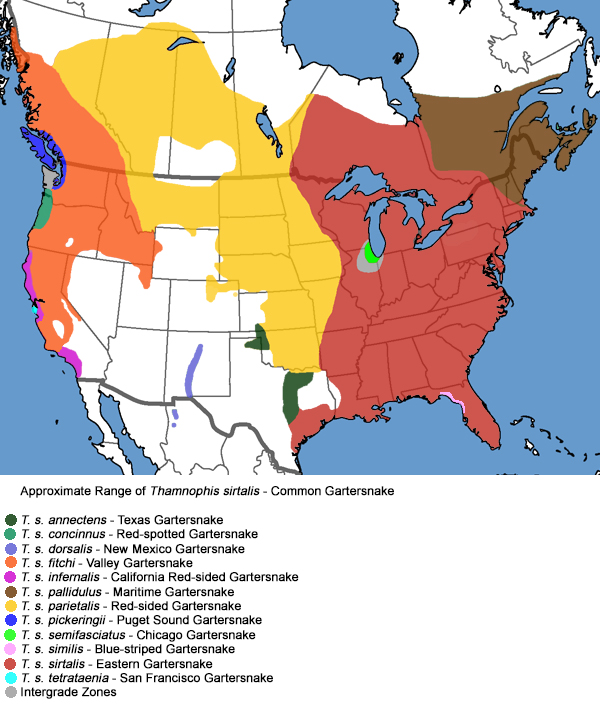 |
| Elevational Range |
Rossman et al (1996) show the elevation record for the species at 8,333 feet (2540 m.). Stebbins (2003) shows it as 8,000 ft. (2,438 m).
This subspecies occurs at much lower elevations along the coast and associated mountains.
|
| Notes on Taxonomy |
SSAR Herpetological Circular No. 43, 2017 shows this note regarding the species Thamnophis sirtalis: "Analyses of mitochondrial and nuclear data suggest that this species may be composed of multiple independently evolving lineages often not concordant with the subspecific taxonomy (F. Burbrink, pers. comm.)."
----------------------------------------------------------------------------------------------------------------------------------------------------------------------------------------------------------------------------
In 1995, Doug Rossman and Jeff Boundy re-named the Thamnophis sirtalis found on the San Francisco Peninsula T. s. infernalis, (removing the name T. s. tetrataenia, but recognizing that the snakes were still subspecifically distinct), and lumped the coastal T. sirtalis with T. s. concinnus. This taxonomy is shown on the range map in the 1996 book, The Garter Snakes - Evolution and Ecology 1. In 1998, Sean Barry and Mark Jennings petitioned the International Commission on Zoological Nomenclature (ICZN) to restore the previous nomenclature 2. With no opposition from Boundy or Rossman, the ICZN agreed to restore the name T. s. tetrataenia to Common Gartersnakes on the San Francisco peninsula 3. Nevertheless, some authors either missed the restoration of this nomenclature or chose to ignore it, and their work still reflects Rossman and Boundy's nomenclature.
(Thanks to Sean Barry for this clarification in a personal communication.)
--------------------------------------------------------------------------------------------------------------------------------------------------------------------
"Jones et al. (2023, Journal of Biogeography 50: 2012–2029) using genome-scale data did not find support for the traditional subspecies of T. sirtalis but rather discovered four distinct geographic lineages across North America. No taxonomic suggestions were indicated."
(Nicholson, K. E. (ed.). 2025 SSAR Scientific and Standard English Names List)
--------------------------------------------------------------------------------------------------------------------------------------------------------------------
Alternate and Previous Names (Synonyms)
Thamnophis sirtalis tetrataenia - San Francisco Garter Snake (Stebbins 1966, 1985, 2003, Stebbins & McGinnis 2012)
Thamnophis sirtalis tetrataenia (Stebbins 1954)
Thamnophis sirtalis parietalis - Western Garter Snake (Coluber parietalis; Coluber infernalis; Eutaenia sirtalis obscura; Eutaenia sirtalis; Tropidonotus parietalis; Eutaenia proxima; Eutaenia imperialia; Eutaenia sirtalis pickeringii; Thamnophis infernalis, part; Thamnophis elegans, part; Eutaenia concinna; Thamnophis parietalis; Eutaenia sirtalis parietalis; Eutaenia sirtalis tetrataenia; Eutaenia sirtalis dorsalis. Pacific Garter Snake; Rocky Mountain Garter Snake; Red-barred Garter Snake; California Garter Snake; Churchill's Garter Snake; Dusky Garter Snake; Say's Garter Snake; Striped Snake; Pickering's Garter Snake) (Grinnell and Camp 1917)
|
| Conservation Issues (Conservation Status) |
| Listed as endangered by the state and by the federal government. The habitat of this snake has declined severely due to urban development and agricultural land use and altering of the waterways needed by this snake. These habitat changes have also reduced populations of one of this snake's main food sources, the California Red-legged Frog - Rana draytonii . Some authorities believe that the remaining fragmented populations of this snake could be further threatened by over-collecting for the pet trade. San Francisco Gartersnakes are popular pets in Europe, where it is possible that there are more of these snakes than there are in the wild in California. |
|
| Taxonomy |
| Family |
Colubridae |
Colubrids |
Oppel, 1811 |
| Genus |
Thamnophis |
North American Gartersnakes |
Fitzinger, 1843 |
| Species |
sirtalis |
Common Gartersnake |
(Linnaeus, 1758) |
Subspecies
|
tetrataenia |
San Francisco Gartersnake |
(Cope, 1875) |
|
Original Description |
Thamnophis sirtalis - (Linnaeus, 1758) - Syst. Nat., 10th ed., Vol. 1, p. 222
Thamnophis sirtalis tetrataenia - (Cope, 1875) - in Yarrow, in Wheeler's Rep. Surv. W. 100th Mer., Vol. 5, Zool., p. 546
from Original Description Citations for the Reptiles and Amphibians of North America © Ellin Beltz
|
|
Meaning of the Scientific Name |
Thamnophis - Greek - thamnos = shrub or bush + ophis = snake, serpent
sirtalis - Latin = like a garter - probably refers to the to striped pattern
tetrataenia - Greek - tetra = four + Latin - taenia = stripes or bands, refers to the dorsal color areas
from Scientific and Common Names of the Reptiles and Amphibians of North America - Explained © Ellin Beltz
It is often reported that the name "garter snake" comes from the snake's striped back, which resembles the garters that were once used to hold up men's socks. In Etymology of garter snake evolutionary biologist Colin Purrington posits that "sirtalis" does not mean "like a garter" it means something closer to "ropelike." It follows that "garter snake" does not refer to the appearance of a man's garter, it is more likely "...a misspelling of guarder snake, garden snake, gardener snake, or garten snake."
|
|
Other California Gartersnakes |
T. a. atratus - Santa Cruz Gartersnake
T. a. hydrophilus - Oregon Gartersnake
T. a. zaxanthus - Diablo Range Gartersnake
T. couchii - Sierra Gartersnake
T. gigas - Giant Gartersnake
T. e. elegans - Mountain Gartersnake
T. e. terrestris - Coast Gartersnake
T. e. vagrans - Wandering Gartersnake
T. hammondii - Two-striped Gartersnake
T. m. marcianus - Marcy's Checkered Gartersnake
T. ordinoides - Northwestern Gartersnake
T. s. fitchi - Valley Gartersnake
T. s. infernalis - California Red-sided Gartersnake
|
|
More Information and References |
California Department of Fish and Wildlife
Hansen, Robert W. and Shedd, Jackson D. California Amphibians and Reptiles. (Princeton Field Guides.) Princeton University Press, 2025.
Stebbins, Robert C., and McGinnis, Samuel M. Field Guide to Amphibians and Reptiles of California: Revised Edition (California Natural History Guides) University of California Press, 2012.
Stebbins, Robert C. California Amphibians and Reptiles. The University of California Press, 1972.
Flaxington, William C. Amphibians and Reptiles of California: Field Observations, Distribution, and Natural History. Fieldnotes Press, Anaheim, California, 2021.
Nicholson, K. E. (ed.). 2025. Scientific and Standard English Names of Amphibians and Reptiles of North America North of Mexico, with Comments Regarding Confidence in Our Understanding. Ninth Edition. Society for the Study of Amphibians and Reptiles. [SSAR] 87pp.
Samuel M. McGinnis and Robert C. Stebbins. Peterson Field Guide to Western Reptiles & Amphibians. 4th Edition. Houghton Mifflin Harcourt Publishing Company, 2018.
Stebbins, Robert C. A Field Guide to Western Reptiles and Amphibians. 3rd Edition. Houghton Mifflin Company, 2003.
Behler, John L., and F. Wayne King. The Audubon Society Field Guide to North American Reptiles and Amphibians. Alfred A. Knopf, 1992.
Robert Powell, Roger Conant, and Joseph T. Collins. Peterson Field Guide to Reptiles and Amphibians of Eastern and Central North America. Fourth Edition. Houghton Mifflin Harcourt, 2016.
Powell, Robert., Joseph T. Collins, and Errol D. Hooper Jr. A Key to Amphibians and Reptiles of the Continental United States and Canada. The University Press of Kansas, 1998.
Bartlett, R. D. & Patricia P. Bartlett. Guide and Reference to the Snakes of Western North America (North of Mexico) and Hawaii. University Press of Florida, 2009.
Bartlett, R. D. & Alan Tennant. Snakes of North America - Western Region. Gulf Publishing Co., 2000.
Brown, Philip R. A Field Guide to Snakes of California. Gulf Publishing Co., 1997.
Ernst, Carl H., Evelyn M. Ernst, & Robert M. Corker. Snakes of the United States and Canada. Smithsonian Institution Press, 2003.
Taylor, Emily. California Snakes and How to Find Them. Heyday, Berkeley, California. 2024.
Wright, Albert Hazen & Anna Allen Wright. Handbook of Snakes of the United States and Canada. Cornell University Press, 1957.
Thelander, C. G., ed. Life on the Edge: A Guide to California's Endangered Natural Resources Volume I: Wildlife.
Santa Cruz, California, Biosystems Books, 1994.
Don Roberson's Web Site
1 Rossman, Douglas A., Neil B, Ford, & Richard A. Siegel. The Garter Snakes - Evolution and Ecology. University of Oklahoma press, 1996.
2 Barry, Sean J., and Mark R. Jennings. 1998. Coluber infernalis Blainville 1835 and Eutaenia sirtalis tetrataenia Cope in Yarrow, 1875 (currently Thamnophis sirtalis infernalis and T. s. tetrataenia; Reptilia: Squamata): proposed conservation of the subspecific names by the designation of a neotype for T. s. infernalis. Bulletin of Zoological Nomenclature 55: 224-228.
3 CZN 2000. Opinion 1961. Coluber infernalis Blainville 1835 and Eutaenia sirtalis tetrataenia Cope in Yarrow, 1875 (currently Thamnophis sirtalis infernalis and T. s. tetrataenia; Reptilia: Squamata): conservation of the subspecific names by the designation of a neotype for T. s. infernalis. Bulletin of Zoological Nomenclature 57: 191-192.
Joseph Grinnell and Charles Lewis Camp. A Distributional List of the Amphibians and Reptiles of California. University of California Publications in Zoology Vol. 17, No. 10, pp. 127-208. July 11, 1917.
|
|
|
The following conservation status listings for this animal are taken from the April 2024 State of California Special Animals List and the April 2024 Federally Listed Endangered and Threatened Animals of California list (unless indicated otherwise below.) Both lists are produced by multiple agencies every year, and sometimes more than once per year, so the conservation status listing information found below might not be from the most recent lists. To make sure you are seeing the most recent listings, go to this California Department of Fish and Wildlife web page where you can search for and download both lists:
https://www.wildlife.ca.gov/Data/CNDDB/Plants-and-Animals.
A detailed explanation of the meaning of the status listing symbols can be found at the beginning of the two lists. For quick reference, I have included them on my Special Status Information page.
If no status is listed here, the animal is not included on either list. This most likely indicates that there are no serious conservation concerns for the animal. To find out more about an animal's status you can also go to the NatureServe and IUCN websites to check their rankings.
Check the current California Department of Fish and Wildlife sport fishing regulations to find out if this animal can be legally pursued and handled or collected with possession of a current fishing license. You can also look at the summary of the sport fishing regulations as they apply only to reptiles and amphibians that has been made for this website.
|
| Organization |
Status Listing |
Notes |
| NatureServe Global Ranking |
G5
T2
Q |
The species is: Secure.
This subspecies is: Imperiled.
There are taxonomic questions associated with it.
|
| NatureServe State Ranking |
S2 |
Imperiled |
| U.S. Endangered Species Act (ESA) |
FE |
Listed as Endangered 3/11/1967 |
| California Endangered Species Act (CESA) |
SE |
Listed as Endangered 6/27/1971 |
| California Department of Fish and Wildlife |
FP |
Fully Protected |
| Bureau of Land Management |
None |
|
| USDA Forest Service |
None |
|
| IUCN |
None |
|
|
|



















































